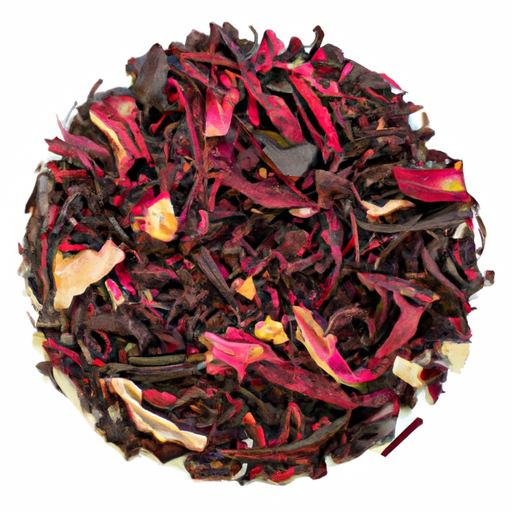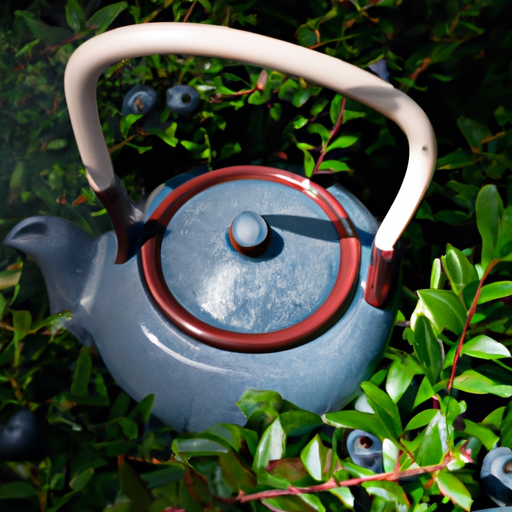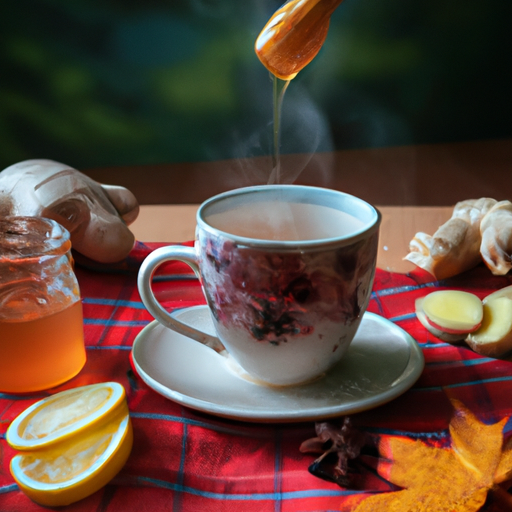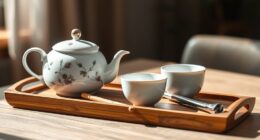It just so happened that I only recently uncovered the subtle but distinct variances between white tea and herbal tea. Being a tea lover, I have always been fascinated by the wide range of flavors and scents that tea provides. However, it wasn’t until I explored further into the realm of tea that I noticed the nuances that distinguish white tea from herbal tea.
Originating from different plants and processed using contrasting methods, white tea and herbal tea offer unique flavor profiles that cater to various tastes. While white tea boasts delicate and floral notes, herbal tea provides a diverse range of flavors, from soothing chamomile to invigorating peppermint.
Moreover, the disparity in caffeine content between these two tea types is noteworthy. While white tea contains a moderate amount of caffeine, herbal tea is entirely caffeine-free, making it an excellent choice for those seeking a calming and caffeine-free beverage.
Join me as we explore the origins, processing methods, flavor profiles, caffeine content, health benefits, steeping methods, popular varieties, and personal preferences and pairings of white tea and herbal tea.
Let’s unravel the mysteries of these two fascinating tea categories and enhance our tea-drinking experiences.
Key Takeaways
- White tea is made from the Camellia sinensis plant, while herbal tea is made from dried herbs, flowers, and fruits.
- White tea has delicate and floral notes, while herbal tea offers a diverse range of flavors.
- White tea contains moderate caffeine, while herbal tea is caffeine-free.
- White tea is rich in antioxidants and may benefit heart health and reduce the risk of chronic diseases, while herbal tea has various health benefits such as aiding digestion, boosting immunity, and promoting relaxation.
Origins and Processing Methods
If you’re curious about the origins and processing methods of white tea and herbal tea, you’ll find that white tea comes from the delicate buds and leaves of the Camellia sinensis plant, while herbal tea is made from various dried herbs, flowers, and fruits.
White tea has its origins in China, where it has been cultivated for centuries. The leaves are carefully handpicked and undergo minimal processing, consisting mainly of withering and drying in the sun or indoors. This gentle processing allows the tea to retain its natural flavors and subtle aroma.
On the other hand, herbal tea is created by infusing dried plants in hot water. The plants are carefully selected and dried to preserve their aromatic and therapeutic properties.
With the origins and processing methods covered, let’s move on to explore the distinctive flavor profiles of white tea and herbal tea.
Flavor Profiles
Contrarily, the flavor profiles of these two teas couldn’t be more distinct. White tea, with its delicate and subtle taste, offers a mild and refreshing experience. It has a light sweetness that is reminiscent of fresh flowers and fruits.
On the other hand, herbal tea boasts a wide range of flavors that cater to different taste preferences. Here are four examples of herbal teas and their distinct flavor profiles:
- Chamomile: Known for its calming properties, chamomile tea has a soothing taste with hints of apple and earthy undertones.
- Peppermint: Refreshing and invigorating, peppermint tea has a cooling taste with a strong, minty flavor.
- Rooibos: This South African herbal tea has a naturally sweet and nutty profile, often compared to vanilla and honey.
- Ginger: Spicy and zesty, ginger tea offers a warming sensation with a hint of citrus.
Moving on to the next section about caffeine content, it’s important to consider how these flavor profiles are affected by the presence or absence of caffeine.
Caffeine Content
The caffeine content in white tea and herbal tea is one of the key differences between the two. While white tea contains a moderate amount of caffeine, herbal tea is naturally caffeine-free.
This disparity in caffeine levels greatly impacts the flavor profiles of each tea, offering tea enthusiasts a unique experience. White tea’s caffeine content provides a subtle energy boost and a slightly bitter taste, while herbal tea’s lack of caffeine results in a milder, more soothing flavor.
It’s important to note that the presence or absence of caffeine also affects the health effects of these teas. While white tea’s caffeine can provide a gentle stimulant effect, herbal tea’s lack of caffeine makes it a great choice for those seeking a calming and caffeine-free beverage.
This difference in health benefits will be explored in the subsequent section.
Health Benefits
White tea is rich in antioxidants and may have potential benefits for heart health and reducing the risk of chronic diseases. It’s a great choice for those looking to boost their overall health.
On the other hand, herbal tea offers a wide range of health benefits as each herb has its own unique properties. Whether you’re looking to aid digestion, boost immunity, or promote relaxation, there’s an herbal tea that can help.
White Tea – Rich in antioxidants and may have potential benefits for heart health and reducing the risk of chronic diseases
Loaded with antioxidants and potentially beneficial for heart health, white tea is like a soothing elixir for the body, offering protection against chronic diseases. White tea is made from the leaves of the Camellia sinensis plant, using minimal processing techniques. This preserves its delicate flavor and high levels of antioxidants, such as catechins and polyphenols, which have been linked to various health benefits.
Studies suggest that white tea may help reduce the risk of heart disease by improving cholesterol levels and reducing blood pressure. Additionally, its antioxidants may have anti-inflammatory properties, potentially protecting against chronic conditions like cancer and diabetes.
It’s worth noting that while white tea is generally safe for most people, it does contain caffeine and may have potential side effects, such as sleep disturbances or increased heart rate. Transitioning to herbal tea, each herb has its own unique health benefits, such as aiding digestion, boosting immunity, or promoting relaxation.
Herbal Tea – Each herb has its own unique health benefits, such as aiding digestion, boosting immunity, or promoting relaxation
Indulging in herbal tea can be a transformative experience, as each unique herb offers a multitude of health benefits that can enhance digestion, boost immunity, and promote a sense of relaxation. To fully enjoy the benefits of herbal tea, consider these five key herbs:
- Chamomile: Known for its calming properties, chamomile tea promotes relaxation and helps relieve stress and anxiety.
- Peppermint: This refreshing herb aids digestion, soothes stomach discomfort, and can provide relief from headaches.
- Ginger: With its immune-boosting properties, ginger tea can help combat colds and flu, reduce inflammation, and aid digestion.
- Lavender: Known for its calming effects, lavender tea can promote relaxation, reduce insomnia, and alleviate anxiety.
- Echinacea: This herb is well-known for its immune-boosting properties, helping to prevent and alleviate cold and flu symptoms.
Now that you know the benefits of herbal tea, let’s move on to the next section about different steeping methods.
Steeping Methods
When steeping herbal tea, it’s fascinating to note that the flavors and aromas bloom like a vibrant bouquet, offering a sensory experience that transports you to a lush garden.
Different steeping techniques can bring out the best in each herb, allowing you to fully enjoy their unique health benefits.
For delicate herbs like chamomile or mint, a shorter steeping time of around 3-5 minutes at a lower temperature of 175°F is recommended to retain their delicate flavors.
On the other hand, stronger herbs like ginger or hibiscus can withstand a longer steeping time of 7-10 minutes at a higher temperature of 205°F to extract their robust flavors.
Once you’ve mastered the art of steeping, you can explore popular varieties of herbal tea, each offering its own delightful combination of flavors and benefits.
Popular Varieties
When it comes to white tea, some popular varieties include Silver Needle, White Peony, and Longevity Eyebrow. These teas are known for their delicate flavors and subtle aromas, making them a favorite among tea enthusiasts.
On the other hand, herbal tea offers a wide range of options, with popular choices like Chamomile, Peppermint, and Rooibos. These herbal teas are loved for their soothing properties and unique flavors.
White Tea – Silver Needle, White Peony, and Longevity Eyebrow are some popular varieties
If you’re looking to explore the world of white tea, you’ll be delighted by the popular varieties such as Silver Needle, White Peony, and Longevity Eyebrow.
White tea, known for its delicate flavor and light color, has its origins in China. It is made from the youngest leaves and buds of the tea plant, which are carefully handpicked and gently dried.
Silver Needle, with its long, silver-colored buds, is considered the highest grade of white tea. White Peony, also known as Bai Mu Dan, is made from the young leaves and buds that are slightly more mature. Longevity Eyebrow, named after its thin, twisted shape, is another popular variety with a unique taste.
These varieties of white tea offer a delightful and refreshing tea experience.
- Silver Needle: Delicate flavor, highest grade of white tea
- White Peony: Made from slightly more mature leaves and buds
- Longevity Eyebrow: Unique taste, thin and twisted shape
Moving on to herbal tea – chamomile, peppermint, and rooibos are among the many popular herbal tea options.
Herbal Tea – Chamomile, Peppermint, and Rooibos are among the many popular herbal tea options
Moving on from the popular varieties of white tea, let’s delve into the world of herbal tea. Herbal tea is a delightful beverage made from various herbs and plants, offering a range of flavors and health benefits.
Chamomile is a well-loved herbal tea known for its calming properties and soothing effects on digestion. It’s often enjoyed before bedtime to promote relaxation and a restful sleep.
On the other hand, peppermint tea is known for its invigorating flavor and ability to relieve stomach discomfort. Its refreshing taste and cooling sensation make it a popular choice for hot summer days.
Additionally, herbal teas like Rooibos are cherished for their caffeine-free nature and unique flavors. These herbal teas offer a delightful alternative to traditional tea and can be enjoyed at any time of the day.
Transitioning into the next section, let’s now explore personal preferences and pairings, allowing you to discover your perfect cup of tea without missing a beat.
Personal Preferences and Pairings
Although everyone has different tastes, it’s impossible to resist the delightful harmony that arises when you find the perfect tea to complement your personal preferences. When it comes to personal preferences, exploring different tea options can be a rewarding journey.
Here are three items to consider when it comes to personal preferences and food pairings:
- Fragrant herbal teas like chamomile can be a soothing choice to enjoy after a heavy meal or before bedtime. Its calming properties make it a popular choice for relaxation.
- Peppermint tea, with its refreshing and invigorating flavor, pairs well with light meals or as a refreshing drink on a hot summer day.
- Rooibos tea, known for its rich, earthy taste, is a versatile choice that can be enjoyed on its own or paired with a variety of foods, such as chocolate or spicy dishes.
Exploring the world of tea and discovering the perfect pairing for your personal preferences can be a delightful adventure.
Frequently Asked Questions
Can white tea and herbal tea be blended together to create a unique flavor profile?
Yes, white tea and herbal tea can be blended together to create a unique flavor profile. By combining their delicate and subtle flavors, the blending possibilities are endless, allowing for exciting flavor experimentation.
Are there any specific health risks associated with consuming white tea or herbal tea?
When it comes to specific health benefits, both white tea and herbal tea offer a range of advantages. However, it’s important to note that there can be potential side effects associated with consuming these teas.
Are there any cultural or historical significance attached to the consumption of white tea or herbal tea?
Cultural and historical significance is attached to the consumption of white tea and herbal tea. They have been valued for centuries in different cultures for their healing properties, rituals, and as symbols of hospitality and social gatherings.
Can white tea or herbal tea be used in cooking or baking?
Cooking with white tea adds a delicate, floral flavor to dishes, while baking with herbal tea infuses a variety of flavors such as mint, chamomile, or hibiscus. The possibilities are endless, creating unique culinary experiences.
Can white tea or herbal tea be consumed by pregnant women or individuals with specific medical conditions?
White tea and herbal tea can be consumed during pregnancy, but it is important to consult with a healthcare professional. They may have different effects on medical conditions, so it’s best to discuss individual circumstances with a doctor.
Conclusion
In conclusion, the differences between white tea and herbal tea are quite distinct.
White tea, originating from the delicate buds and leaves of the tea plant, undergoes minimal processing, resulting in a subtle and nuanced flavor profile. On the other hand, herbal tea, crafted from various herbs, flowers, and spices, offers a wide range of flavors and health benefits.
While white tea contains a small amount of caffeine, herbal tea is caffeine-free. Ultimately, the choice between the two depends on personal preferences and desired health benefits.
So, whether you prefer the gentle elegance of white tea or the vibrant flavors of herbal tea, there’s a perfect brew waiting to be explored.










